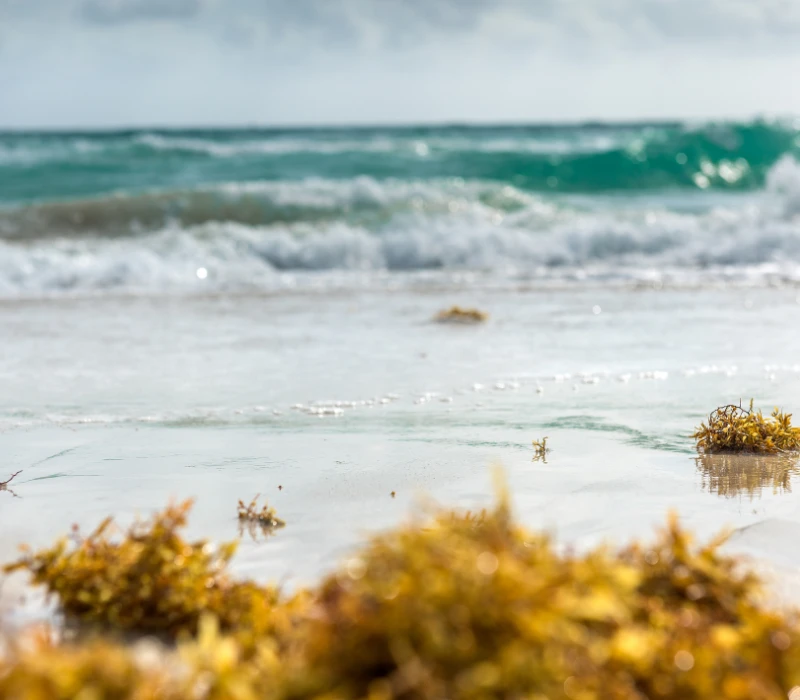Nothing spoils a beach holiday like sargassum.
Not the dry humor the English are famous for, but the collective name given to the massive brown carpet of seaweed comprised of algae and other marine plants originating in the Sargassum Sea.
When sargassum beaches, it begins to rot and stink, spoiling a trip to the beach instantly.
If you are planning a trip to Florida this summer, you may have heard of the seaweed problem off the coast.
Here is a detailed report on the seaweed conditions in Florida for 2023 to help you plan your beach holiday accordingly.
Florida Seaweed Problem 2023
Table of Contents
Current (Present) Seaweed Conditions In Florida
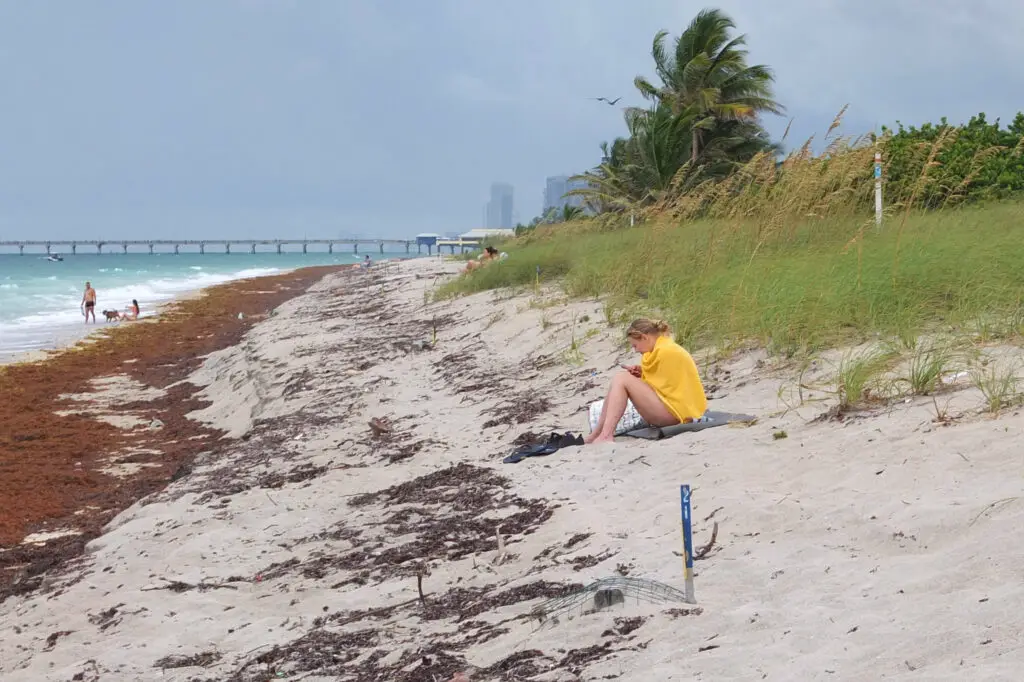
Sargassum gathers and grows in the borderless Sargassum Sea in the Atlantic Ocean. It’s a haven for marine life but a hindrance to fishing boats, beachgoers, and hatching turtles when it creeps up close to shore.
The Gulf Stream moves the sargassum bloom into the Atlantic Basin every year. It spreads and grows in warm temperatures, moving towards the Caribbean, Mexico, Florida Keys, Florida mainland, and up America’s east coast.
In recent years the seaweed mass has been growing exponentially, forcing scientists to start tracking the yearly blooms.
Popular holiday destinations like Playa del Carmen in Mexico, Jamaica in the Caribbean, and various beach destinations in Florida are affected by the stinky brown carpet of algae.
The University of South Florida implemented a seaweed monitoring system called Sargassum Watch System (SaWS). They can track the Atlantic seaweed blooms using NASA and National Oceanic and Atmospheric Administration satellites.
The idea behind the tracking of sargassum is to issue forecast and seaweed outlook bulletins in real-time to provide data on the natural recurring phenomenon so that countries, states, and cities can plan accordingly to counteract the probability of seaweed beaching on their shores.
The bulletins are not intended to predict the impact on specific beaches or regions during the year, as it’s almost impossible to predict with 100% accuracy what nature will conjure up.
The SaWS system recently picked up a 5,000-mile carpet of seaweed weighing an estimated 6.1 million tons, extending from West Africa to the Caribbean Sea and the Gulf of Mexico.
The March 2023 bulletin doesn’t bode well for the Caribbean or Florida regions typically affected by sargassum in a season that spans from March to October, peaking in June, July, and August.
As predicted by the College of Marine Science (the University of South Florida, some areas in the Florida Keys have already been affected by the rotten egg-smelling (due to releasing hydrogen sulfide) seaweed. The scary part is that it’s way earlier than expected.
Florida Seaweed Forecast For 2023
In the last decade, sargassum has consistently piled up on beaches throughout the Caribbean and a host of Florida beaches, growing to massive blobs that stretch for miles, weighing tons. The brown algae caused so much damage to Barbados that a national emergency was declared in 2018.
What is the seaweed forecast for Florida for 2023?
The answer is that residents and visitors to the Sunshine State should expect sargassum deposits in the Florida Keys and multiple Florida east coast beaches.
According to Scientific American, the amount of seaweed that separates from what scientists dub the “Great Atlantic Sargassum Belt” is minuscule when you consider that the seaweed belt is twice the width of the United States.
Miniscule in the grand scheme of seaweed things, but the “smaller” breakaway pieces that find their way onto Florida beaches can cause serious havoc with the economy and the environment when dressing beaches in miles of brown sludge.
Seaweed has already made it onto the Florida Keys beaches and the eastern coast of Florida much earlier compared to previous years.
Professor of oceanography at the local University of South Florida, Dr. Chuanmin Hu, has been studying the sargassum phenomenon for the past 20 years. He states that even though we’re seeing a lot of seaweed deposits along the Florida Keys and east coast of Florida earlier than in previous years, “most of it will arrive in the summer.”
Dr. Hu explained that most beaches could be spared, noting that “even in hot spots, like Miami Beach, sargassum won’t pour in every week or even every month between now and October.”
Hu mentioned that clumps will appear on the beach when the “tide is high, and the wind is blowing from east to west, pushing seaweed toward shore.”
The east coast of North America will be affected the most as seaweed and other debris get pulled by the Gulf Stream along the Atlantic coast. Due to the proximity to the Gulf Stream, Miami Beach and West Palm Beach are routinely hit by seaweed deposits.
Popular Florida east coasts beaches like Delray Beach and South Beach Park in Boca Raton had more than 2 feet of sargassum on their shores in 2022. Expect beached sargassum from Miami Beach to Cape Canaveral at different times and at different beaches throughout the season.
When strong currents, high temperatures, and certain directional winds team up, the result will be seaweed-affected Florida beaches. Beach regions on the Atlantic side without strong currents will trap sargassum. The only question is when and where.
Even when the county or city has a cleanup plan for affected beaches, it’s getting more difficult to keep up with the larger amounts that find their way to the east coast beaches every year.
During the summer, when humidity and water temperature are higher, the decaying seaweed poses a real problem regarding smell and removal, as favorable summer conditions promote fast growth. Beached seaweed will start rotting within 2 days, attracting flies and sending visitors running.
Before booking a holiday on the Florida coast, the best advice is to ask a local authority about the current seaweed situation in the area you plan to visit. Many hotels will perform a daily cleanup of the beach area in front of the property, so conversing directly with the hotel isn’t a bad idea.
Most Seaweed-Affected Beaches Or Regions In Florida In 2023
Predicting what areas or beaches will be hit by the brown carpet of algae is impossible because weather plays a massive part in the process. Tides, currents, and strong winds all conspire when dumping copious amounts of seaweed on previously pristine beaches.
We know that Florida Keys, Key West, and other east coast Florida beaches are more at risk than areas and beaches found on Florida’s west coast. Year-on-year, the east coast is inundated with sargassum, whereas the west coast of Florida seems less affected.
Planning your holiday on the west coast of Florida will result in a relatively sargassum-free holiday if you’re lucky. However, you might be welcomed by a red tide algae bloom which is as devastating to a holiday as the sargassum.
Major sargassum beaching events are inescapable, especially when holidaying in the Caribbean, along the ocean side of the Florida Keys, or on the east coast of Florida. However, the exact timings and locations are difficult to predict. Looking back at the past decade, we all know that a constant seaweed threat blooms large every summer.
Each county will have a plan in place that deals with seaweed deposits, which means that most seaweed-affected beaches on the east coast of Florida will have county or state maintenance plans in place to ensure that beaches are relatively seaweed-free.
The most-seaweed affected beaches or regions in Florida in 2023, when looking back at the previous year’s sargassum activity, and predicted (without exact timings) by the University of South Florida, are the following:
- Florida Keys (ocean-side beaches)
- Key West (ocean-side beaches)
- Miami
- Fort Lauderdale
- Daytona Beach
- Cape Canaveral
- Any beach along the east coast of Florida could be affected at any time during the sargassum season.
Best Seaweed-Free Beaches Or Regions To Visit In Florida In 2023
If you’re looking for seaweed-free beaches, head on to the west coast of Florida. Be sure to contact the establishment you plan to stay at to inquire about the sargassum and red tide situation.
Sargassum deposits are a natural occurrence worldwide and will reach beaches on Florida’s west and northwest coast but tend to be more manageable than the large amounts expected to beach on the east coast.
The best, relatively seaweed-free regions to visit in Florida in 2023 are the following west coast areas:
- Pensacola
- Panama City Beach
- Tampa Bay
- Fort Mayers
- Naples
Relatively seaweed-free doesn’t mean that you won’t find sargassum on the beach, but rather that the seaweed situation isn’t overwhelming and of such a nature that it will spoil your holiday. Sargassum is unpredictable and can wash ashore at any given time.
One area that’s currently not affected by seaweed or red tide is Venice, located in Sarasota County, Florida. Beaches that are seaweed-free in the area include the following popular beaches:
- Caspersen Beach
- South Brohard Beach and Paw Park
- Brohard Beach
- Venice Beach
- North Jetty Beach
- Nokomis Beach
Current Seaweed Conditions In Destin
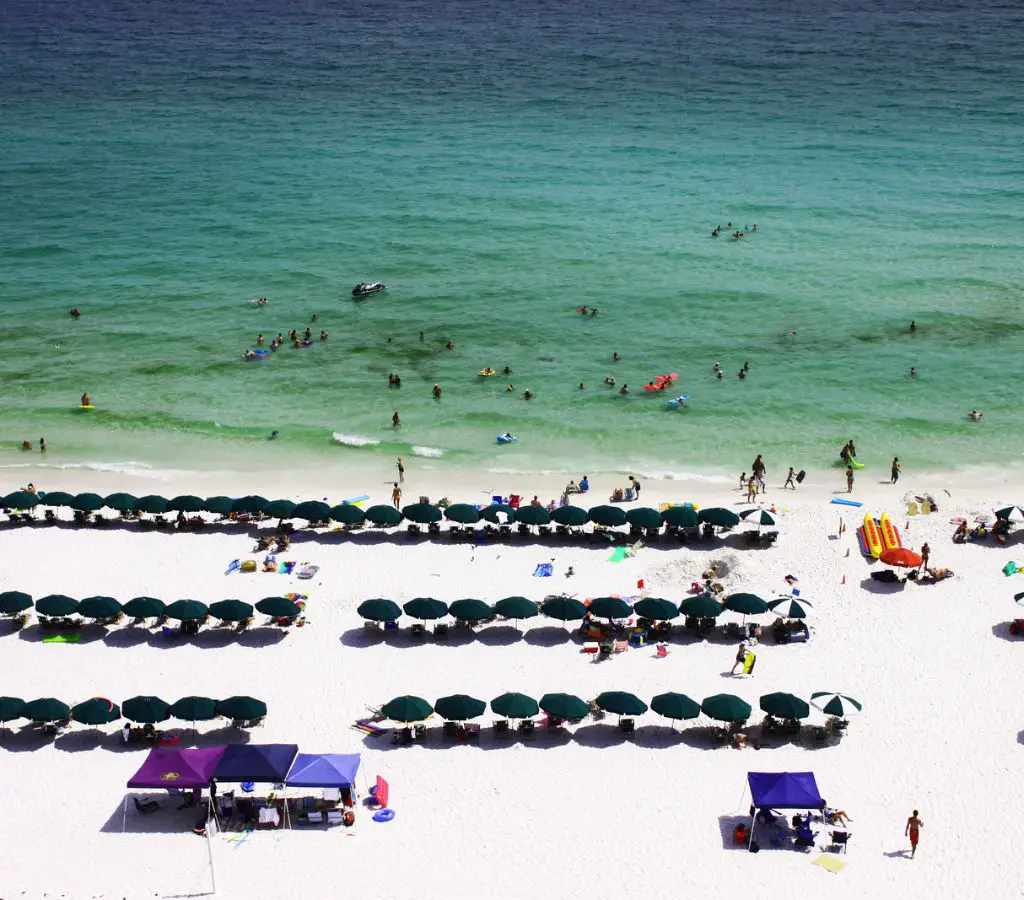
As reported by WKRG News 5 in March 2023, no sargassum or red tide is currently affecting the beaches of Destin and Fort Walton. Officials of Okaloosa County are adamant that should sargassum wash up on shore, their staff will be ready.
Nick Tomecek, Public Information Officer in Destin, had this to say regarding the sargassum pile-ups, “While we have typically allowed nature to dispose of sargassum on our beaches, we are prepared to utilize properly permitted tools on our beach to remove the seaweed if needed.”
Beaches that are currently unaffected by sargassum in the Destin area include:
- Blue Mountain Beach
- Crab Island
- Crystal Sands
- Dune Allan Beach
- Eglin Matterhorn Beach
- Henderson Beach State Park
- John Beasley Park
- James Lee Beach
- Miramar Beach
- Princess Beach
- Topsail Hill Preserve State Park
Current Seaweed Conditions In Miami
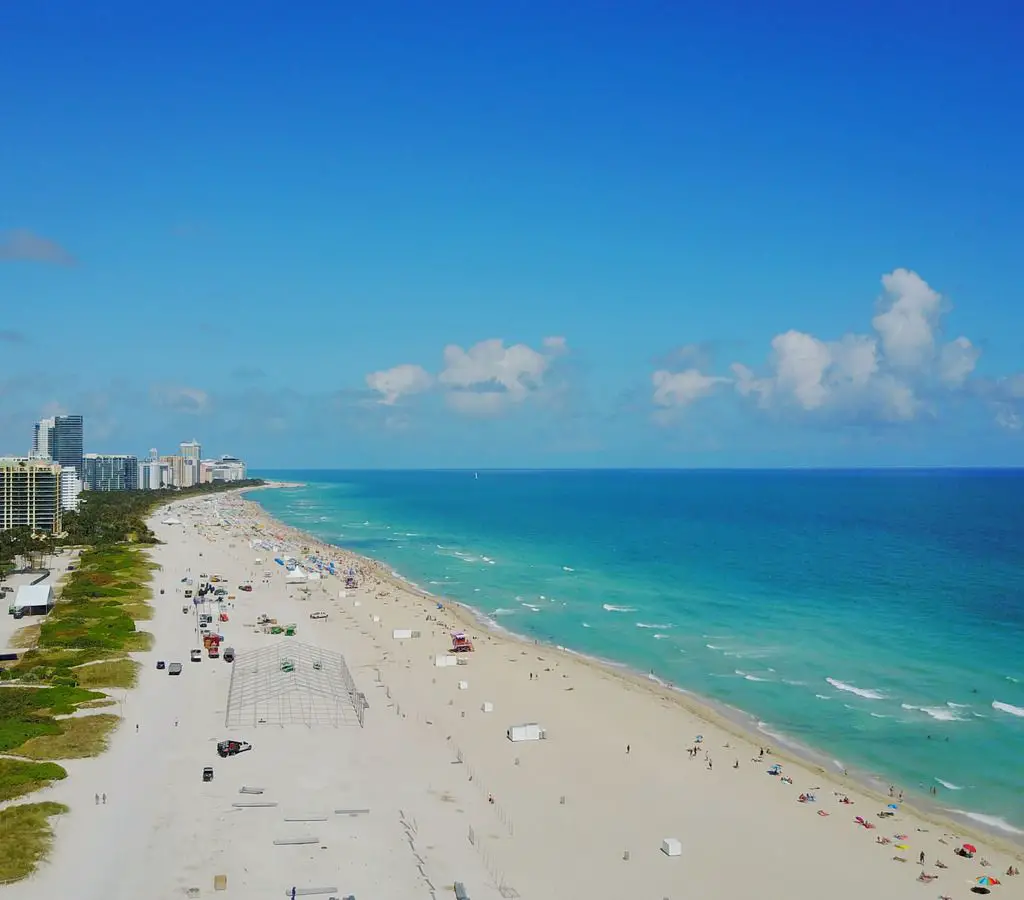
Miami Beach and South Beach suffer from seaweed attacks every year, and should you plan a trip to Miami in 2023, the chances of sharing the beach with sargassum are potentially high depending on the time of year and Mother Nature.
Miami-Dade County employs contractors to remove the sargassum from heavily affected beaches. In less-affected beaches, the contractors use tractors fitted with blades to cut and deposit the seaweed into the sand.
Beaches experience two tides every day. Miami-Dade Park’s beach crews clean seaweed deposits early in the morning, doing their best to ready the beach for visitors and locals. Unfortunately, the afternoon tide often brings more seaweed onto the beach that isn’t cleaned before the following morning.
The chances of encountering large seaweed deposits on Miami beaches between cleanups is a reality, especially from May to July. Miami-Dade County spends millions of dollars yearly to clean up the brown algae from its popular beaches.
Miami-Dade contractors are issued with special state permits to clean the seaweed-affected areas, such as the following:
- North of Government Cut Jetty
- North of Haulover Cut
- South of Haulover Cut
- From 22nd Street through to 32nd Street in Miami Beach
South Beach currently has shoreline seaweed, as reported by the City of Miami but not enough to not enjoy the beach, should you be visiting soon. In the upcoming months, you can expect larger deposits of sargassum to heap up on the beach.
The following beaches in Miami are expected to encounter seaweed deposits at some stage during the sargassum season:
- Bill Baggs Florida State Park
- Crandon Park Beach
- Haulover Beach Park
- Historic Virginia Key Park
- Matheson Hammock Park
- Miami Beach Boardwalk
- South Beach
- Virginia Key Beach North Point Park
Current Seaweed Condition In Hollywood Beach
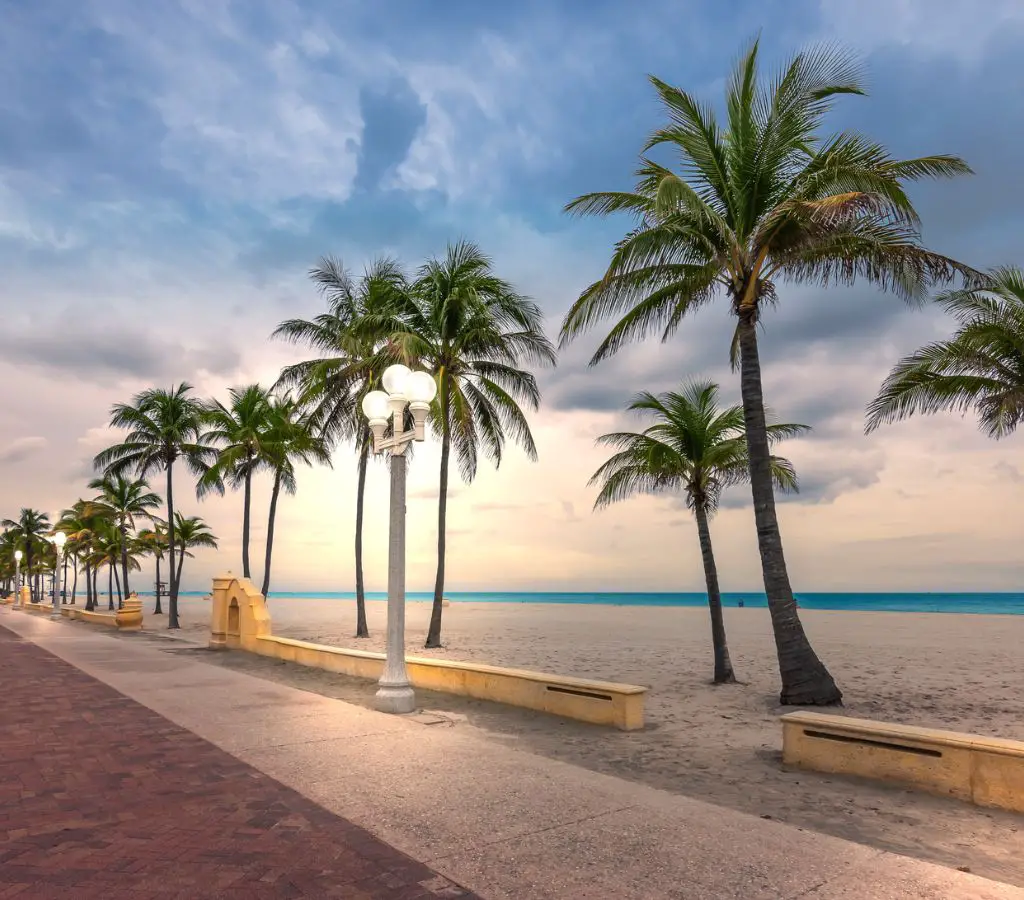
Hollywood Beach is sandwiched between Miami and Fort Lauderdale. The Broward County beach is a beautiful family-friendly beach featuring the famous 2 ½-mile Broadwalk, which allows visitors a leisurely beachside stroll while absorbing some vitamin D.
Like most Florida beaches, expect white sand, clear water, and perfect weather on most days. In years gone by, Hollywood Beach has had issues with sargassum, which turned the water brown, restricting swimmers from enjoying the big blue.
Dania Beach is located a couple of miles north of Hollywood Beach, and its popular Dr. Von D Mizell-Eula Johnson State Park has seen its fair share of sargassum mountains in recent years.
Current Seaweed Conditions In Key West
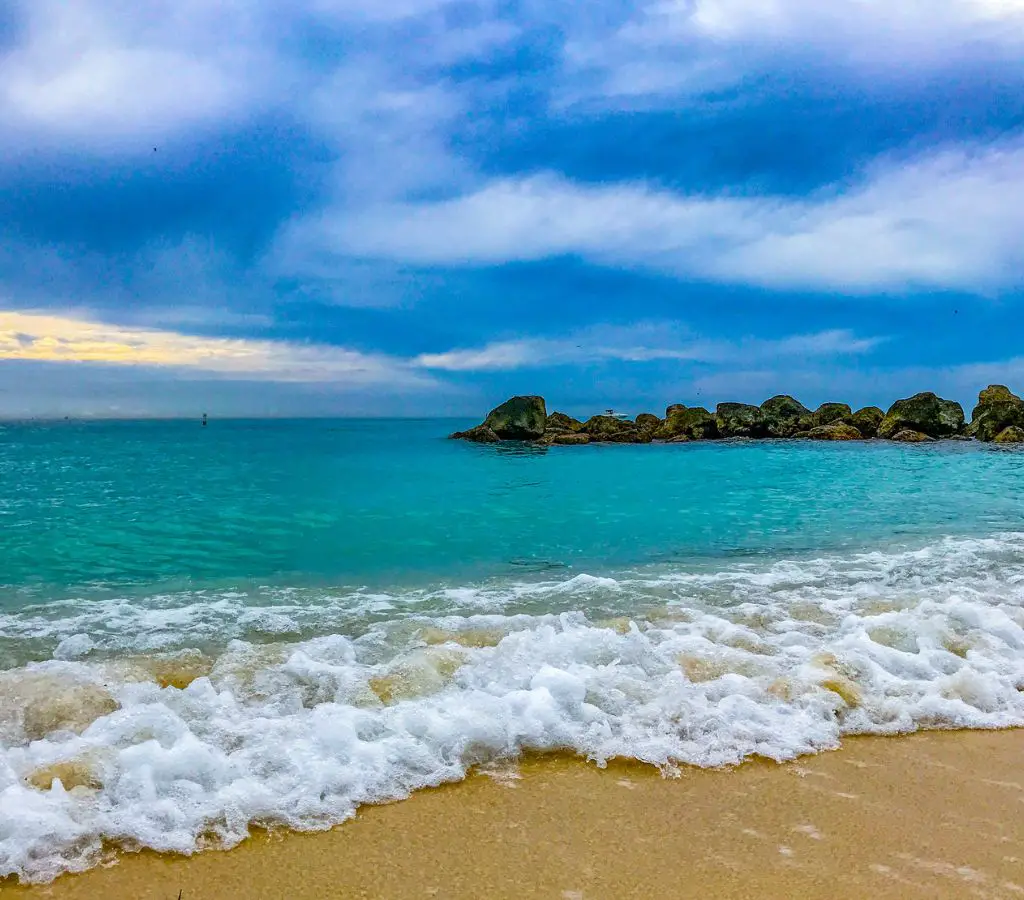
When sargassum hits the beachfront, tourists hit the road. Rockport Analytics did an executive study to assess the impact of sargassum on the Florida Keys, Key West, and Monroe County’s economy and tourism. It makes for grim reading.
It’s estimated that:
- One in ten visitors indicated a 75% chance of trip cancellation to the affected area rather than going where the sargassum is not.
- A big sargassum event can cost the region north $20 million in economic losses.
Sargassum has reached Key West earlier than expected, and Smathers, South Beach, Ford Zachary Taylor Beach, and Geiger Key have encountered seaweed dumps on their shores. Since 2014, sargassum hitting the Keys has become increasingly more abundant.
Beach rake tractors have started up way earlier than locals and visitors would have hoped, and it doesn’t bode well heading into the summer months.
The following beaches have a high possibility of sargassum being dumped with a carpet of algae at some stage during the year:
| Key West Beaches | Probability of Sargassum Issues |
| Smathers Beach | High |
| South Beach | High |
| Clarence S. Higgs Memorial Beach Park | High |
| Fort Zachary Taylor Beach | Medium due to favorable currents |
| Bahia Honda State Park | High |
| Rest Beach | High |
| Dog Beach | High |
| County Beach | High |
The City of Key West has a cleaning contractor tasked with daily beach cleaning, which helps to limit the effect of sargassum deposits on the beaches. Most hotels along the Florida Keys will have a crew of staff or contractors to help keep the beaches as seaweed-free as possible.
Smathers Beach and Clarence S. Higgs Memorial Beach Park are beaches the city and county will clean when the sargassum deposits pile up. Some of these beaches aren’t as bad due to the cleanup activities.
The current found at Ford Zach helps to pull the seaweed away from the beach and out to sea, which helps minimize sargassum deposits. Bahia Honda Beach is left to the mercy of the sea as the county doesn’t clean seaweed deposits from here.
Coco Plum Beach and Sombrero Beach, located in Marathon City, are raked four times a week and more if necessary. Before visiting the Key West area, the best advice is to contact local authorities and inquire about the sargassum situation.
Oh yes, before I forget, you may encounter sargassum at Dog Beach. Luckily, your canine friend will be delighted to run and forage through the stinky piles. If you find the beaches in Key West not up to scratch regarding sargassum levels, hit the sandbars instead!
Current Seaweed Condition In Fort Lauderdale
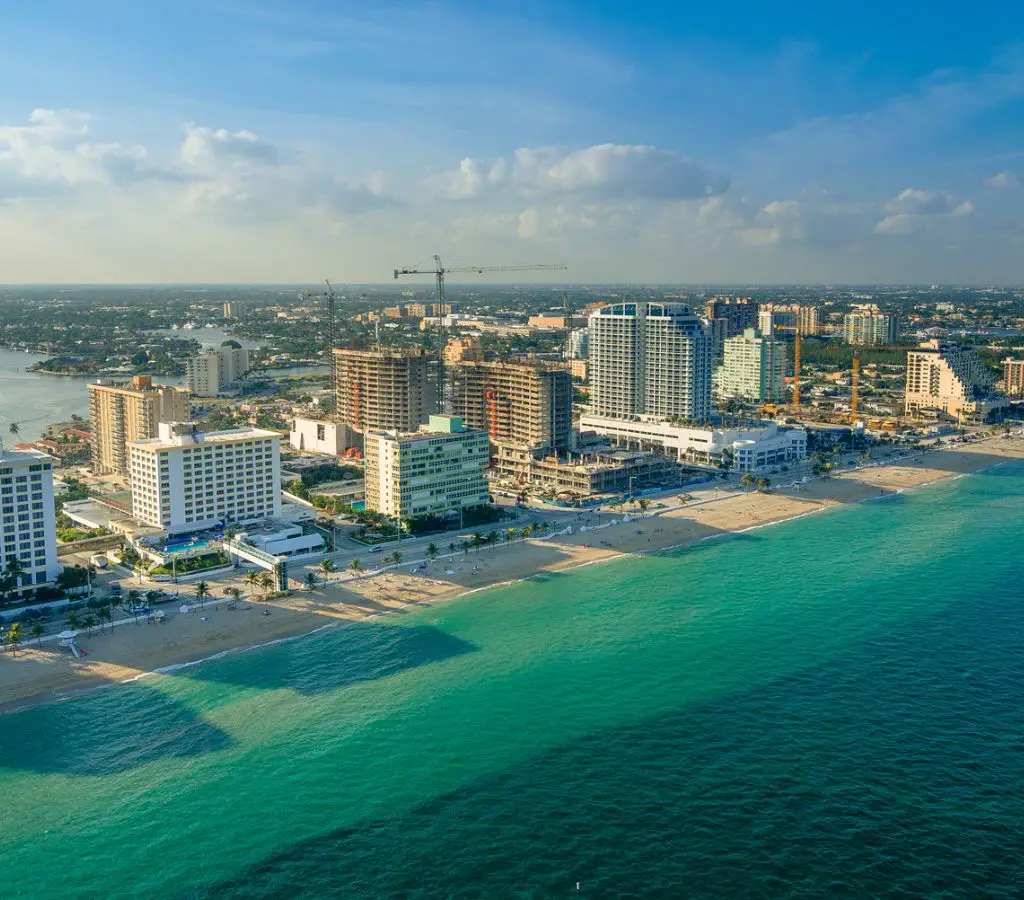
According to local10.com, city officials of Ford Lauderdale have collected twice the amount of sargassum from their beaches compared to this time last year. City officials have acknowledged that they have dedicated sargassum crews cleaning beaches every morning.
Seeing that Ford Lauderdale beaches have to date been hit by twice the amount of seaweed compared to previous sargassum seasons, it’s safe to assume that as we advance, the following beaches have a high possibility of being affected by seaweed until the end of October:
- Ford Lauderdale Beach Park
- Hallandale Beach
- Hollywood Beach
- Hillsboro Beach
- Lauderdale-By-The-Sea Beach
- Vista Park
Ford Lauderdale collects the seaweed and takes it to an open space to let it mature for three months before using it as nutrient-rich soil in planting projects run by the city.
Current Seaweed Condition In Clearwater Beach
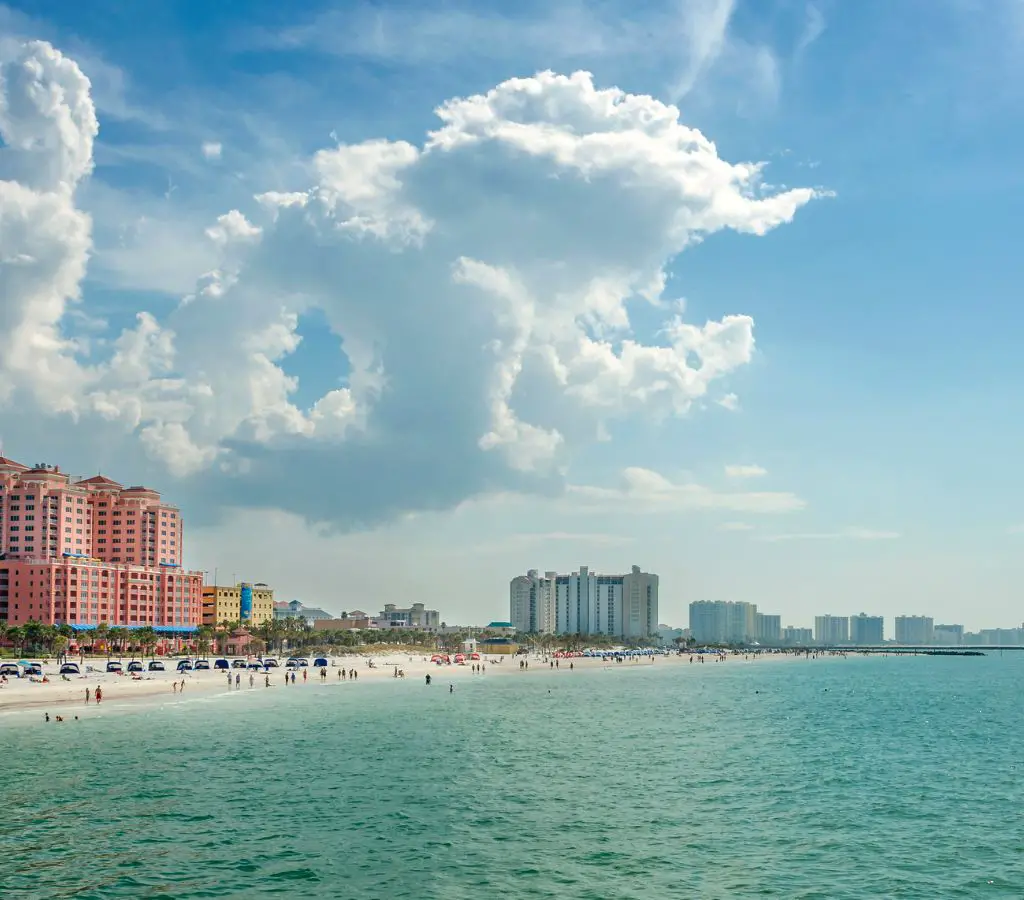
Clearwater, Tampa, and St. Petersburg are the main cities in Tampa Bay, located on the Gulf Coast of Florida. According to sargassum experts, Clearwater Beach is one of the areas that will be least affected by seaweed.
If you’re considering visiting one of the beaches in the Tampa Bay region in the upcoming months, you will be glad to know that according to a local news outlet, WFLA Channel 8 News, the beaches will likely be spared from the dreaded stinky seaweed.
According to information provided by the Dr. Hu of the University of South Florida, the beaches in the Tampa Bay area will likely not experience many sargassum deposits during the seaweed season as ” the west coast of Florida is largely spared every year [and] this year is no exception. “
However, the beaches in the Tampa Bay area can be affected by the current “red tide” conditions found on the southwestern shores of Florida. “Red tide” occurs when toxic algae known as Karenia brevis proliferates. Signs of red tide include:
- Dead fish washing ashore
- Reddish-brown discoloring of the water
It’s recommended that you and your pets stay out of the water when the toxic algae are weaving their destruction, as it could lead to the following:
- Irritation of the skin
- Eye irritation
- Respiratory issues
- Shellfish poisoning when ingesting contaminated shellfish
- Stomach problems
Beaches that are expected to be relatively seaweed-free in the Tampa Bay area include:
- Archibald Beach Park
- Ben T Davis Beach
- Caladesi Island State Park
- Clearwater Beach
- Davis Islands Beach
- Fred Howard Park Beach
- North Beach at Ford De Soto Park
- Honeymoon Island State Park
- Indian Rocks Beach
- John’s Pass Beach
- Madeira Beach
- Picnic Island
- Pass-A-Grille Beach
- Redington Shores Beach
- Sand Key Beach
- Sunset Beach Pavilion
- St. Pete Beach
- Upham Beach Park
- Treasure Island Beach
Current Seaweed Condition In Marco Island
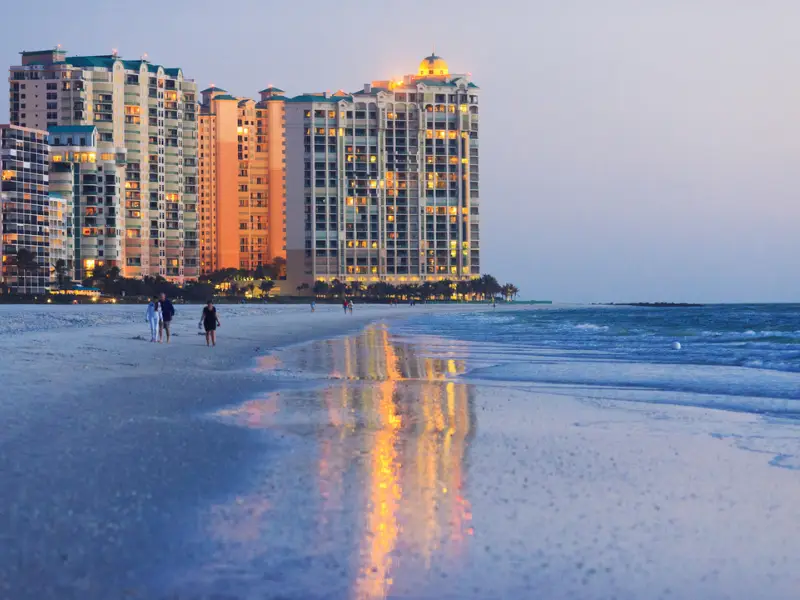
The longest island of Florida’s Ten Thousand Islands, Marco Island, has beautiful beaches rated as the most pristine beaches in the world. A quick look at the live cam situated at Marco Island reveals no trace of sargassum.
The following Marco Island beaches should be relatively unscathed from seaweed attacks due to their location in the Gulf of Mexico or Southwest Florida:
- Keewaydin Island
- Tigertail Beach
- Cape Romano
- South Marco Beach
- Hideaway Beach
- Panther Key Beach
- Marco Island Beach
Current Seaweed Condition In Daytona Beach
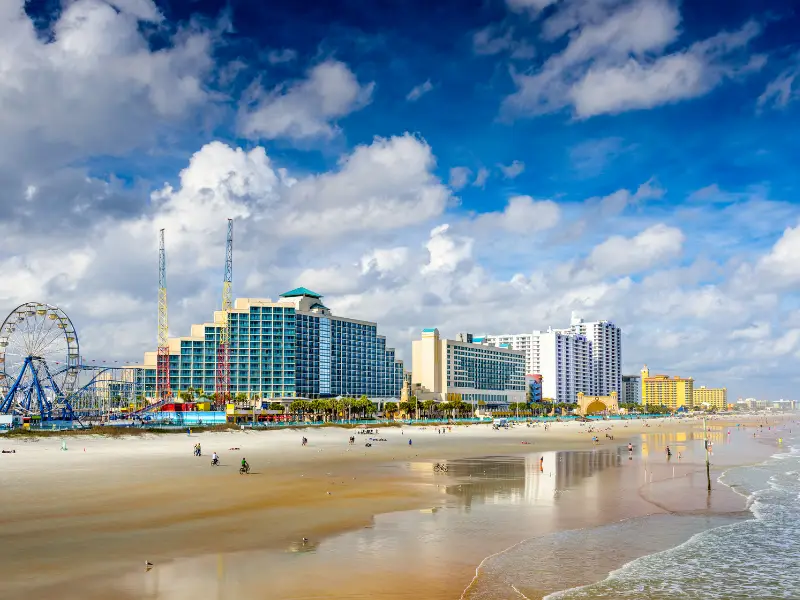
Home to the infamous Daytona International Speedway, and host of the iconic Daytona 500 NASCAR race, Daytona Beach is one of Florida’s crown jewels.
Daytona Beach is a holiday hotspot with awesome beaches, waterparks, free summer concerts, arcades, adrenaline-inducing rides, and eateries lining the boardwalks. These entertainment annuities lose their allure once stinky seaweed hits the shore.
The right (or wrong) combination of currents, wind direction, water, and air temperature can quickly turn the healthy marine carpet at sea into a smelly, health-affecting problem on the beach.
Situated on Florida’s Atlantic coast, Daytona Beach is in the firing line when the summer sargassum season starts in earnest. Jetty Park was bombarded with seaweed last July, giving residents and visitors a smelly reminder of the potent smell of decomposing seaweed.
The following beaches located in the Daytona Beach area have a high possibility of sargassum deposits during 2023:
- Al Weeks Sr. North Shore Park
- Bicentennial Park Beach
- Daytona Beach Shores
- Lighthouse Point Park Beach
- Mary McLeod Bethune Beach Park
- New Smyrna Beach
- Smyrna Dunes Park Beach
- Sun Splash Park
Current Seaweed Condition In Cocoa Beach
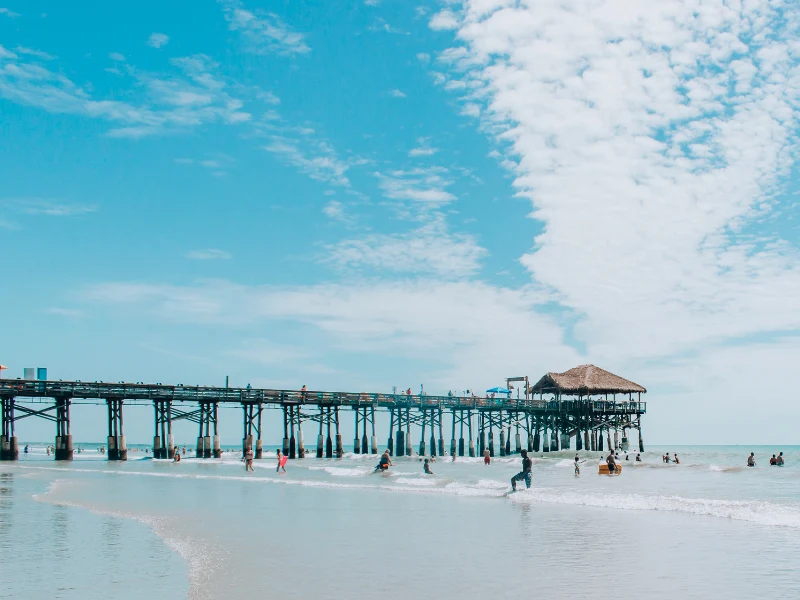
The Cocoa Beach Pier has been a very popular surfing spot since the 1960s. Some call it the birthplace of professional East Coast surfing, and older folk refer to it as Canaveral Pier.
The current seaweed condition in Cocoa Beach is one of “What seaweed”? However, the picture can change later in the year for residents and visitors alike.
Officials of Brevard County are preparing for a worst-case scenario later in the year as a big sargassum season is expected.
Brevard County normally doesn’t clean the beaches when seaweed strikes, but a proactive plan has been implemented due to the size of the threat and the danger the seaweed presents to nesting turtles and their young.
Cue a 900-pound beach-cleaning robot called “Bebot,” which may or may not have its hands full of seaweed in the summer months. A betting man won’t bet against the sargassum.
Current Seaweed Condition In Siesta Key
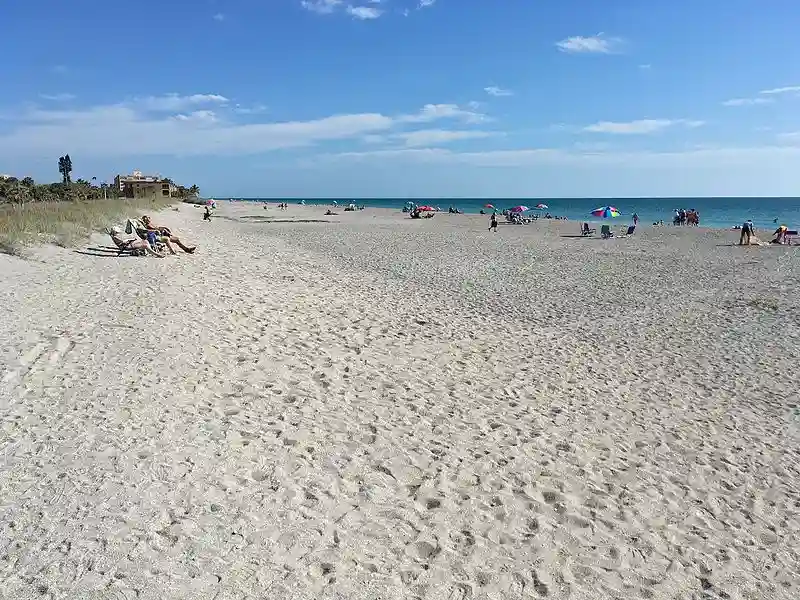
Siesta Key Beach is rated as one of the best beaches in the United States. The 8-mile beach is a snorkeler’s paradise with crystal-clear waters and pillow-soft sand. Siesta Key is not immune to seaweed deposits in the past.
Currently, the beaches in Siesta Key are unaffected by sargassum deposits, and hopefully, the trend will continue as we move into the sargassum season. The following beaches are not experiencing issues with sargassum deposits at present:
- Crescent Beach
- Point of Rocks Beach
- Sarasota Beach
- Siesta Key Beach
- Sunset Beach
- Turtle Beach Park
The beaches listed above are currently not affected by “red tide” conditions either.
Current Seaweed Condition In Panama City Beach
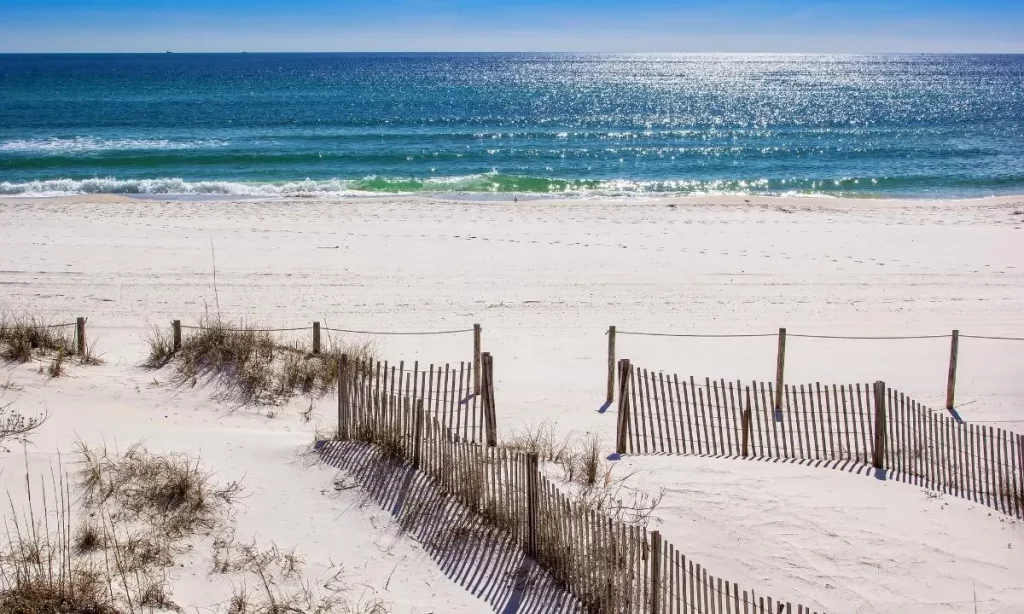
Panama City Beach, like any other city on the coast of Florida, is ready for any influx of sargassum onto its beaches. Big Bend beaches were upgraded to medium risk of sargassum influx by the National Oceanic and Atmospheric Administration in March 2023.
Typically, east coast beaches are not severely affected by sargassum, so it’s something to remember when planning a trip to Panama City beaches.
The following beaches are included in the medium risk assessment:
- Camp Helen State Park Beach
- Dog Beach
- M.B. Miller Pier
- Panama City Beach
- Rick Stelzer Park
- Schooners
- Shell Island
- St. Andrews State Park Beach
Panama City beaches get raked thrice weekly to ensure no sargassum build-up.
Conclusion
Florida will likely experience a massive sargassum season in 2023. With authorities and business owners proactively cleaning the mess from the beaches as efficiently as possible, you don’t have to cancel a trip to Florida due to sargassum fears.
As you can’t predict where sargassum will beach during the summer months as the algae carpet makes its way up the east coast of the United States, it’s best recommended to contact local authorities to get an idea of the seaweed situation before booking a trip to Florida.
Seaweed experts predict that the west coast of Florida will be less affected, so there’s that piece of helpful information when deciding which side of the mainland to visit.
Seaweed-affected Florida beaches is the new normal going forward.
Related Posts
✅ Cancun SEAWEED Conditions [2022]: A Detailed Guide!!
✅ Playa del Carmen SEAWEED Crisis [2022]: A Detailed Guide!!
✅ Tulum SEAWEED Conditions [2022]: A Detailed Guide!!
✅ Punta Cana SEAWEED Problem (2022): Everything You Need To Know!!
✅ Isla Mujeres SEAWEED Problem in 2022? Everything You Need to Know!
✅ Cozumel SEAWEED Problem (2022): Everything You Need To Know!
✅ Aruba SEAWEED Problem (2022): Everything You Need To Know!!
✅ Puerto Rico Seaweed Problem 2022: Everything You Need to Know!
References
https://oceanservice.noaa.gov/facts/sargassosea.html
https://optics.marine.usf.edu/projects/saws.html
https://www.tampabay.com/news/environment/2023/03/14/seaweed-sargassum-beaches-florida-bloom-record/
https://www.foxweather.com/extreme-weather/massive-seaweed-blobs-florida-beaches-spring-break
https://ocean.si.edu/ocean-life/plants-algae/what-exactly-red-tide
https://www.floridamuseum.ufl.edu/earth-systems/blog/red-tide-karenia-brevis/
https://www.axios.com/local/miami/2023/03/22/florida-seaweed-blob-tracker
